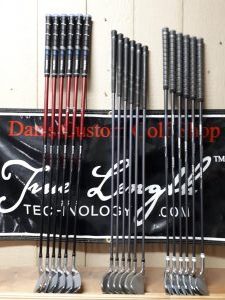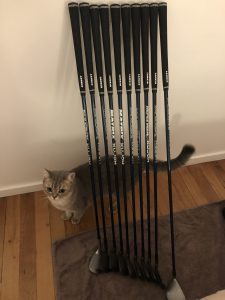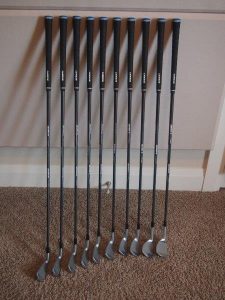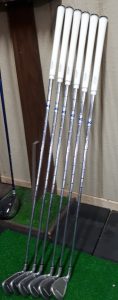The TLT in pictures page was setup to help golfers get a better understanding of how a True Length Technology® set of irons will keep every player athletic.
Please enjoy our second short video
TLT in pictures clearly demonstrates 2 positions, one athletic (TLT), and one non athletic address (original set).
Here is my tallest player (6′ 8″) who came to me struggling with his game. Other golf shops offer a plus 1″ set but this still did nothing for his address.
TLT in pictures, player 1
1 – His original sand wedge is way too short, virtually eliminating all chances of playing a strong game.
2 – His new True Length Technology Series 15 custom built sand wedge which does promote a strong athletic address position – comfortable.
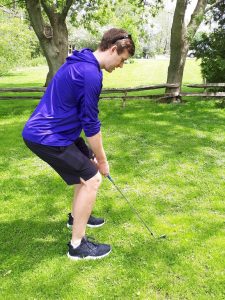
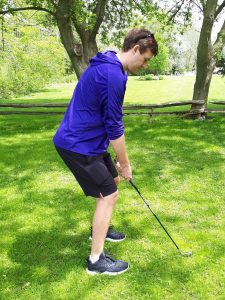
Now this golfer has the opportunity to develop his game from 1 singular athletic address position.
His original set had him squatting with excessive spine tilt (with every club). Even his long irons created address discomfort and a great deal of miss hits, with topping the ball being the biggest flaw.
Now he remains athletic and has the opportunity to take his game to the next level.
Another True Length Technology® success story.
TLT design – promoting a consistent hand position
- Consistent with TLT set
- Inconsistent with the OEM set
This set of True Length Technology® irons are set up against a wall, keeping their true lie angle relative to the floor. The resultant length of each of these golf clubs ends up at the exact same hand position relative to a correct lie angle. This will promote a singular athletic address position with more on center hits as well as a very repeatable and consistent swing plane.
How is this different from a traditional set of golf clubs?
Pay attention to the grip cap position
- This set is built with 1* lie angle change on the 4 – PW, then same lie wedges
- Lengths are built to the progressive TLT math model, promoting a singular athletic address position
Common address position
OEM designs – promoting a variable hand height position
This is an OEM build that will force a variable hand position. The player will be forced to squat with the short irons and grip down on the long irons.
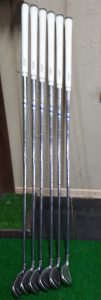
Here is a standard OEM build – 2 views
Shown; 4 iron thru 9 iron –> notice the variable hand height
- The 4 – 9 iron are 1/2″ length increments and 1/2* lie angle change / club
- Lie angles are set correctly against the floor – this OEM design forces a variable grip height
- Result – the player is forced to alter their address with every club, due to the a lack of consistency in the design of length and lie.
- This OEM build will not promote a repeatable consistent swing nor swing plane. The player will be forced to crouch for a club (9 iron) that is too short or grip down on a club that is too long 4 iron).
The OEM math is incorrect which does force a variable address position and hand position for every club. Altering how you hold each individual club is not desirable. Consistency is what golfers are after and the OEM length and lie design cannot accomplish this.
Book your True Length Technology® Fitting today with the developer of this Award Winning Fitting System – Dan Connelly.
TLT fitting charts are available in 16 different length build combinations which will allow the petite to be fit just as well as a giant of a man.
TLT in Pictures – Player 2
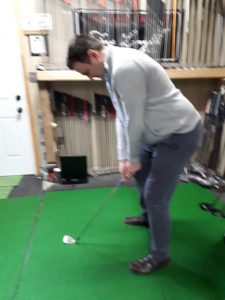
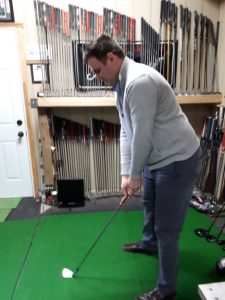
Here is a 6’4 player with a 38 wrist to floor measurement. He is a good player that deals with lower back issues and could not get comfortable with anything less than a 4 iron
Picture 1 – His original Sand wedge where he is clearly squatting and bent over too far. This poor address will result in poor consistency and wayward shots.
Picture 2 – His new Sand wedge built to a TLT Series 12. Now standing athletic with the shortest club in his bag.
TLT in Pictures – Player 3
Here is another one of my taller players. In the the first picture the 7 iron is simply too short and he is forced to play with excessive spine tilt.
With the TLT 7 iron in his hands he is standing taller and with a more upright spine position. He is overall in a superior athletic address position. This strong address position will be maintained throughout the entire set.

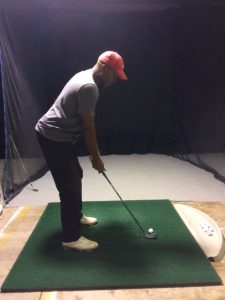
Single length, OEM length, TLT length
Shown below are 3 sets of 6 – SW in 3 different configurations – Single Length, OEM, TLT
On the left is the longest single length set I have ever built – where each iron is 40.2″ long at a 65* lie angle (for every club). This was for a 6’4″ man with a 41″ wrist to floor measurement.
The middle set is an OEM brand that represents if this man had simply gone into a golf store and bought a boxed set. The 1/2″ length change verses the 1/2* lie angle change will force address changes and will lower your consistency. The length varies 2 1/2″ over these 6 clubs
The RH set is a TLT Series 6 that details the reduced length increment that a TLT build represents. Notice that the longest iron in the OEM set and the TLT set are near the same length. However the shortest iron in the OEM set is clearly nearly 1″ shorter than the shortest club in the TLT set. The TLT set only has roughly 1 1/2″ of length variation over the 6 clubs. The TLT set is also designed with 1* lie change per club.
The OEM model will force an average player to squat with a short iron and grip down on the long iron.
The TLT will do the same as the single length set and will keep you athletic regardless of which club you choose.
